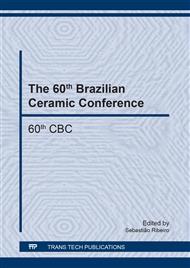[1]
P. Guerrero, P.M. Stefani, R.A. Ruseckaite, K. De la Caba: Journal of Food Engineering Vol. 105 (2011), p.65.
Google Scholar
[2]
B.S. Chiou, R.J. Avena-Bustillos, P.J. Bechtel, S.H. Imam, G.M. Glenn, W.J. Orts: Journal of Food Engineering Vol. 95 (2009), p.327.
DOI: 10.1016/j.jfoodeng.2009.05.011
Google Scholar
[3]
M. Pereda, A.G. Ponce, N.E. Marcovich, R.A. Ruseckaite, J.F. Martucci: Food Hydrocolloids Vol. 25 (2011), p.1372.
DOI: 10.1016/j.foodhyd.2011.01.001
Google Scholar
[4]
M. Nagarajan, S. Benjakul, T. Prodpran, P. Songtipya: International Journal of Biological Macromolecules Vol. 75 (2015), p.388.
Google Scholar
[5]
A. Duconseille, T. Astruc, N. Quintana, F. Meersman, V. Sante-Lhoutellier: Food Hydrocolloids Vol. 43 (2015), p.360.
DOI: 10.1016/j.foodhyd.2014.06.006
Google Scholar
[6]
M.F.C. Jorge, C.H.C. Flaker, S.F. Nassar, I.C.F. Moraes, A.M.Q.B. Bittante, P.J.A. Sobral: Journal of Food Engineering Vol. 120 (2014), p.81.
Google Scholar
[7]
J.W. Rhim: Carbohydrate Polymers Vol. 86 (2011), p.691.
Google Scholar
[8]
M. Huskić, M. Žigon, M. Ivanković: Applied Clay Science Vol. 85 (2013), p.109.
Google Scholar
[9]
S.D. Lee, M.S. Park, D.W. Kim, Il Kim, D.W. Park: Catalysis Today Vol. 232 (2014), p.127.
Google Scholar
[10]
A. Farahnaky, S.M.M. Dadfar, M. Shahbazi: Journal of Food Engineering Vol. 122 (2014), p.78.
Google Scholar
[11]
M. Kotal, A.K. Bhowmick: Progress in Polymer Science Vol. 51 (2015), p.127.
Google Scholar
[12]
F.M. Fakhouri, S.M. Martelli, T. Caon, J.I. Velasco, L.H.I. Mei: Postharvest Biology and Technology Vol. 109 (2015), p.57.
Google Scholar
[13]
J. Hua: Applied Clay Science Vol. 114 (2015), p.239.
Google Scholar
[14]
C.D. Mu, X.Y. Li, Y.G. Zhao, H.G. Zhang, L.J. Wang, D.F. Li: Journal of Applied Polymer Science Vol. 128 (2013), p.3141.
Google Scholar
[15]
S. Acosta, A. Jiménez, M. Cháfer, C. González-Martínez, A. Chiralt: Food Hydrocolloids Vol. 49 (2015), p.135.
DOI: 10.1016/j.foodhyd.2015.03.015
Google Scholar
[16]
A. Giannakas, K. Grigoriadi, A. Leontiou, N.M. Barkoula, A. Ladavos: Carbohydrate Polymers Vol. 108 (2014), p.103.
DOI: 10.1016/j.carbpol.2014.03.019
Google Scholar
[17]
S. Shankar, X. Teng, G. Li, J.W. Rhim: Food Hydrocolloids Vol. 45 (2015), p.264.
Google Scholar
[18]
L. Ge, X. Li, R. Zhang, T. Yang, X. Ye, D. Li, C. Mu: Food Hydrocolloids Vol. 51 (2015), p.129.
Google Scholar
[19]
C.H.C. Flaker, R.V. Lourenço, A.M.Q.B. Bittante, P.J.A. Sobral: Journal of Food Engineering Vol. 167 (2015), p.65.
Google Scholar
[20]
J.W. Rhim: Food Research International Vol. 51 (2013), p.714.
Google Scholar


